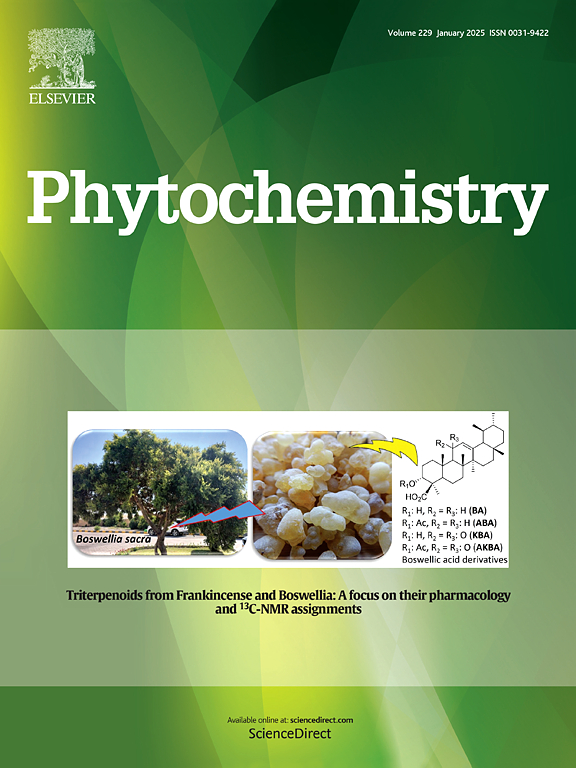从太白贝母的球茎中分离出的柏木碱型等甾体生物碱A−O及其抗神经炎和乙酰胆碱酯酶抑制活性
IF 3.4
2区 生物学
Q2 BIOCHEMISTRY & MOLECULAR BIOLOGY
引用次数: 0
摘要
从太白贝母的鳞茎中分离得到了15种未描述的西瓦宁型等甾体生物碱,其中贝母paines A−O(1−15)和12种已知的类似物(16−27)。基于光谱学、电子圆二色光谱和单晶x射线衍射数据分析,完全阐明了先前描述的化合物的结构,包括它们的绝对构型。化合物3、5、6对脂多糖诱导的BV-2小胶质细胞NO释放具有显著抑制作用,IC50值分别为6.3、10.7、6.7 μM。所有化合物均显示无或微弱的乙酰胆碱酯酶抑制活性。网络药理学分析和分子对接结果提示,3可能通过肿瘤中的通路、PI3K-Akt信号通路、Rap1信号通路等,以及结合PIK3CA、AKT1、SRC、PIK3R1、ITGB1靶点来治疗阿尔茨海默病。本文章由计算机程序翻译,如有差异,请以英文原文为准。

Frititaipaines A−O, undescribed cevanine-type isosteroidal alkaloids from the bulbs of Fritillaria taipaiensis and their anti-neuroinflammatory and AChE inhibitory activities
Fifteen undescribed cevanine-type isosteroidal alkaloids, frititaipaines A−O (1−15), and twelve known analogs (16−27) were isolated from the bulbs of Fritillaria taipaiensis. The structures of the previously undescribed compounds, including their absolute configurations, were fully elucidated based on spectroscopic, electronic circular dichroism spectra, and single-crystal X-ray diffraction data analysis. Compounds 3, 5, and 6 displayed significant inhibitory effects against lipopolysaccharide induced NO release in BV-2 microglial cells with IC50 values of 6.3, 10.7, and 6.7 μM, respectively. All compounds showed no or weak acetylcholinesterase inhibitory activities as determined by the Ellman's method. Network pharmacological analysis and molecular docking results suggest that 3 may be able to treat Alzheimer's disease through pathways in cancer, PI3K-Akt signaling pathway, Rap1 signaling pathway, etc., as well as by binding PIK3CA, AKT1, SRC, PIK3R1, and ITGB1 targets.
求助全文
通过发布文献求助,成功后即可免费获取论文全文。
去求助
来源期刊

Phytochemistry
生物-植物科学
CiteScore
6.40
自引率
7.90%
发文量
443
审稿时长
39 days
期刊介绍:
Phytochemistry is a leading international journal publishing studies of plant chemistry, biochemistry, molecular biology and genetics, structure and bioactivities of phytochemicals, including ''-omics'' and bioinformatics/computational biology approaches. Phytochemistry is a primary source for papers dealing with phytochemicals, especially reports concerning their biosynthesis, regulation, and biological properties both in planta and as bioactive principles. Articles are published online as soon as possible as Articles-in-Press and in 12 volumes per year. Occasional topic-focussed special issues are published composed of papers from invited authors.
 求助内容:
求助内容: 应助结果提醒方式:
应助结果提醒方式:


